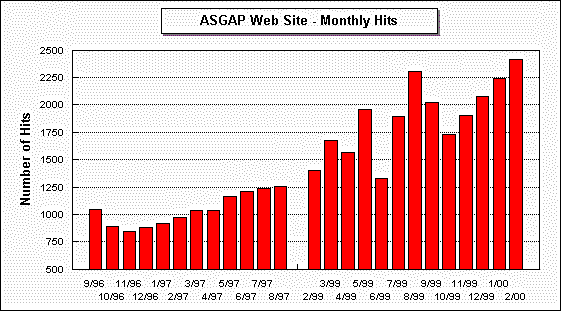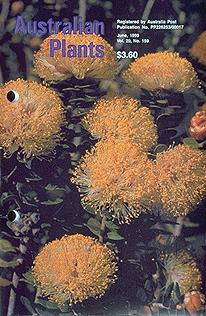|
[Front Page] [Features] [Departments] [Society Home] [Subscribe]

First Cuttings
Australian Plants Societies
Australian Plants online is brought to you by the 7 Societies that make up the Association of Societies for Growing Australian Plants (ASGAP).
Have you ever thought of joining one of the Societies? There is a Regional Society in every Australian state and also in the Australian Capital Territory. In addition, there are over 100 district groups established in centres throughout Australia.
Membership brings many benefits - regular district group and Regional newsletters, the colour journal "Australian Plants", access to free seed banks, regular meetings with expert speakers, bush walks, garden visits, advice from experienced growers, access to difficult to obtain plants and access to Study Groups.
Why not take a look at the Membership Page and see what we have to offer?

What's Wrong with Botanical Names??
As much as I enjoy the journal "Australian Geographic" (I've been a subscriber since it was first published in 1986), its editorial policy on plant names is more than a little annoying. It seems that there is a fear that, if a correct scientific name for a plant is published, the readership will desert in droves!
It's difficult to understand what other explanation there could be, because the magazine often comes up with the most extraordinary "common" names in an effort to avoid anything Latin-like.
In the most recent issue, for example, an excellent article on the ecology and geology of the Blue Mountains was trivialised by the use of the name "barbed wire bush" to describe a rare pea flowered plant.
Now I've been around Australian native plants for a long time and while I don't claim to be an expert in nomenclature, I reckon I've got a reasonable handle on names that are used commonly by the masses, particularly plants of the Blue Mountains area. And I've never heard of a "barbed wire bush" and it seems that very few others have either. I checked several well known references on Australian plants and could find no mention of it. I also checked the online common names database, again without result. Not that I expected to find it....it is an uncommon plant, after all, so why should it have a common name?
I understand that many people find botanical names intimidating (or at least difficult to remember). Fair enough. And I'm very much in favour of using a common name where one exists. But, if obscure common names are going to be used (or, as I suspect, invented?) why can't the scientific name be placed in parentheses? Then people who want to know more about a particular plant might have some hope of tracking it down.
As it happens, I still don't know what a barbed wire bush is, except that its a pea-flowered plant. It could be a Pultenaea or a Dillwynia or a Phyllota or an Aotus or.....
The problem is that AG isn't even consistent in its policy on plant names. On page 29 of the same issue, a description of a bird orchid is accompanied by the scientific name (Pterostylis barbata).
There....I've had my winge! None of which detracts from the fact that Australian Geographic is an excellent publication. If you haven't come across it before, you might like to check out the web site.

Water Conservation Garden
The Water Conservation Garden in the Royal Botanic Gardens, Melbourne has recently been with financial assistance from South East Water. The Garden is designed to help visitors learn more about how to create and maintain low or no-water gardens.
Originally established six years ago, the west-facing Water Conservation Garden has been planted with 80 different species from all over the world, including Australia, Africa, the Americas, southern Europe and the Canary Islands.
Further information from the South East Water web site.

Although this Forum has no connection with ASGAP, it's an excellent resource that allows people to post questions and receive answers on anything to do with Australian native plants. It's worth logging on just to read through some of the previous questions and replies - you're sure to learn something new! I certainly did.
And while your there...please take the time to contribute an answer to any questions you might be able to answer, even in part. I'm now directing to the Forum many of the inquiries received via the ASGAP web site so that the wide knowledge base shared by APOL subscribers can be widely accessed.

Web Site Activity Increases
As a niche site, the ASGAP web site is never going to attract a huge amount of traffic, but activity on the site is certainly increasing. For those who may be interested, the diagram below indicates the increase in "hits" over the past few years. Of course, web statistics only give an approximate idea of activity but there's more than enough to keep the web site co-ordinator busy!


Net Watch
A few sites you might like to check out......
Scribbly Gum
The Lab (ABC Science Online) has launched a new feature called "Scribbly Gum: events in nature", for anyone who loves the natural world.
"Scribbly Gum" peers into backyards and the bush to find out what happens as the natural world changes with the seasons ... this month features Australian Wader birds about to migrate to Siberia. Last month celebrated the arrival of baby blue tongue lizards which normally arrive into the world in late February.
The site has lots of pictures, downloadable audio interviews, and even a Forum, where you can ask questions or tell others about your latest backyard discoveries....
CSIRO News Flash
Thanks to Val Williams for bringing this one to my attention.....
This is an open mailing list which delivers CSIRO Press Releases to your mailbox at regular intervals - up to 5 or 6 per week. Each item covers recent news from CSIRO research and while the items are not restricted to plant news, most are very interesting and informative. For example, did you know that coffee grounds filter out heavy metals from water?? So who needs water filtration devices? (that's what I love about research - you can accept the findings that justify your vices and ignore the findings that don't!!!).
To subscribe, just enter your email address in the box on CSIRO's web site:
Two recent plant items of interest from News Flash.....
Cedar Tip Moth
Red cedar (Toona ciliata, once known as 'red gold', is a valuable and highly sought-after timber in increasing demand throughout Asia and Australia. Natural stands of the timber are diminishing and continued logging increases the environmental problems in already fragile ecosystems.
Attempts to establish plantations of red cedar and other related species in SE Asia and Australia have been unsuccessful in the past, due to attack from the Cedar Tip Moth (Hypsipyla robusta). The moth's larvae eat the developing shoots, which causes deformity of the tree trunk, extensive branching, and stunted growth, making the tree virtually useless for timber.
CSIRO Entomology and the Queensland Forestry Research Institute (QFRI) are collaborating with forestry and scientific organisations in Thailand, the Philippines, Laos and Malaysia to identify resistant species and to determine what causes them to be resistant, and to develop silvicultural practices that reduce tip moth attack. WA tackling billion dollar weed problem
Weeds are estimated to cost the Australian economy more than $3.3 billion per year. Biological control of weeds aims to bring some of the more important national weeds under control and reduce their impact in a safe and environmentally benign manner.
To help address the problem, a quarantine facility is being built at CSIRO's Floreat Park site. The facility will streamline the process of testing potential biological control agents and will reduce the cost associated with each project. The facility will allow screening of potential biological control agents to be completed in WA and will help to deliver results at a smaller cost in a shorter time frame.
While on the subject of weeds you might like to check out this listing by the Weed Science Group of Agriculture WA.
The site sets out to document all those garden plants that have become environmental weeds somewhere in Australia. So far there are 719 entries with the following fields:
- Family Genus species subsp
- Alternate names
- Common Names
- States where species are reported to be environmental weeds
- States where the species are noxious
- Notes
Also listed are "sleepers" - weeds which have not yet attracted attention, either through a long lag phase prior to explosive spread or species that may just need a small change in land management practices to become problems.

Australian Plants....in print!!!
"Australian Plants online" is a fairly recent publication of the Association of Societies for Growing Australian Plants but the Society has been involved in publishing for much longer....since 1959 to be exact, when the first issue of the journal "Australian Plants' was published.


"Australian Plants" is a 48 page, quarterly journal packed with information of practical interest to the average grower but also including reports on recent scientific research. The journal is liberally illustrated with colour photographs and drawings and has built up a high reputation since its first issue in 1959. It is held in many libraries both in Australia and overseas.
The journal regularly features up-to-date information on new species, new cultivars and hybrids, new propagation techniques and plant identification changes.
The "Australian Plants" journal is included with Society membership (either as a standard benefit or by means of an additional fee). It is also possible to subscribe to independently of Society membership. The cost is $18 annually ($AUS32 overseas), including postage. If you would like to subscribe, print out the Subscription Form and post or fax the appropriate fee to the address indicated on the form.
Here's a sample of some of the topics covered in recent issues,
Smoke induced germination
Tea trees
The "Honeypot" Dryandras
Bernawarra Gardens - Tasmania
Plants for wet areas
Philotheca and Eriostemon - name changes
Lilly Pilly cultivars
Tropical legumes
Eucalyptus cinerea - lignotuber studies
Nutritional needs of Proteaceae
Labichea and Petalostylis
Xyris in Australia
Ferns in a garden
Yellow Waratah...Telopea truncata form
"Pines" of Tasmania
Tasmanian plants in horticulture in Britain
Eucalypts of Tasmania
Cut flower production trials
Emu Bush - Growing Eremophila
Kangaroo Paws - for colour
Creating a native garden...For beginners
Native honeysuckle; The genus Lambertia
Fertilizing for grevilleas
Creating homes for birds and mammals
Mistletoe; their natural biological control
|
Vegetation of Macquarie Island
Grevillea - care and maintenance
Proteaceae of the rainforest
Richmond Birdwing butterfly
Terrestrial orchids of Royal National Park
Bladderworts - carnivorous plants
New Banksia releases
Edible wattle seeds - southern Australia
An introduction to legumes of Australia
Orchids as garden features
Native lowland grasslands of Tasmania
Orities - Tasmanian endemics
Gardening in clay
The daisy family
The tea tree oil industry
Riceflower - an everlasting daisy as a cut flower
Corkwood as a source of medicine
Outback Gardening - Achieving water efficiency
Pioneering Quandong as a fruit
Commercial cropping in the dry Interior
Bush food plantations
Rainforest plants - horticulture and bush tucker
Native fruits - Aboriginal food
About plant roots
NSW Christmas Bush: Cut flower industry
|
[Back to Top]
Good growing
Brian Walters

[Front Page] [Features] [Departments] [Society Home] [Subscribe]
Australian Plants online - March 2000
Association of Societies for Growing Australian Plants
|